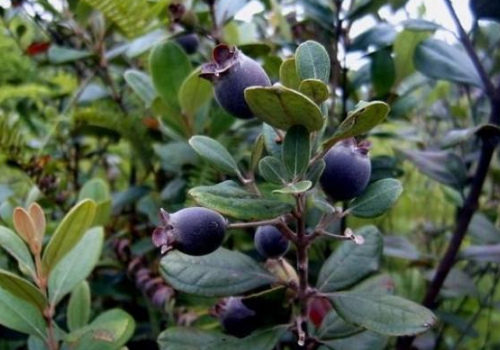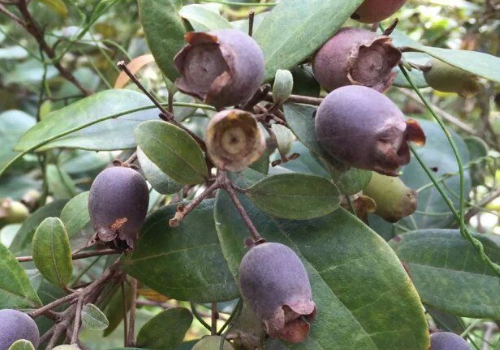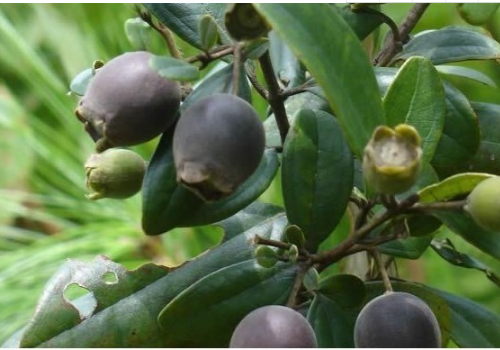Is Myrtle poisonous? what are the breeding methods?
The fruit of myrtle has good nutritional and medicinal value, and can also be used to soak wine to drink. So is myrtle poisonous? What are the methods of reproduction?
Is myrtle toxic?
Myrtle is not poisonous and can be picked and eaten when Myrtle is ripe. Myrtle belongs to the myrtle family, a total of 72 genera, 2752 species, are tropical plants, mostly famous fruit trees and a variety of useful plants. Myrtle is a common wild fruit in the mountain when she was a child, and each place has different names, such as: Dorney, Gangzu, Shanyu, Duolian, Dangli, Nim, Doumin, Zhongni, Wuwei, Peach Aunt, Dangnu and so on.

What are the breeding methods of myrtle:
I. seed breeding method
Before sowing, we should first select the seeds. Whether the seeds are good or not is directly related to the success of sowing. It is best to choose the seeds harvested in the same year. The longer the seed is preserved, the lower the germination rate is. Choose seeds with full grains, no defects or deformities, and no diseases and insect pests. Families usually soak the seeds in hot water for about 60 ℃ for a quarter of an hour, and then use warm hot water to accelerate germination for 12 to 24 hours. The best way to disinfect the substrate used for sowing is to stir-fry it in a pan so that any diseases and insects can be scalded to death. Soak the seeds in warm hot water (the temperature is about the same as facial wash) for 12 to 24 hours until the seeds absorb water and expand. For common seeds that germinate easily, this work does not have to be done. For tiny seeds that are difficult to pick up with hands or other tools, wet one end of the toothpick with water, stick the seeds one by one on the surface of the matrix, cover the substrate 1 cm thick, and then put the seeding pot into the water. The depth of the water is 1 stroke 2 feet 2 tap 3 of the height of the flowerpot, allowing the water to soak up slowly. For larger seeds that can be picked up by hand or other tools, put the seeds directly into the substrate and order them at a distance of 3 × 5 cm. After sowing, the substrate was covered, and the thickness of the cover was 2-3 times that of the seed. After sowing, you can use sprayers and fine-hole showers to wet the sowing matrix, and later, when the basin soil is slightly dry, you should still pay attention to the watering strength not to wash the seeds up.
Management after sowing: after sowing in late autumn, early spring or winter, when you encounter a cold wave and low temperature, you can wrap the flowerpot with plastic film to keep warm and wet; after the seedlings are unearthed, the film should be opened in time, and before 9:30 every morning, or after 3:30 in the afternoon, let the seedlings receive the sun's light, otherwise the seedlings will grow very weakly. After most of the seeds come out, they need to plant seedlings properly: pull out the diseased and unhealthy seedlings, so that the seedlings left behind have a certain space between each other; when most of the seedlings have three or more leaves, they can be transplanted.
2. Cutting propagation method
When the tender wood cuttings were carried out, the sturdy branches of the current year were selected as cuttings when the plants were growing vigorously from the end of spring to early autumn. After cutting off the branches, select the sturdy parts and cut them into segments 5-15 cm long, each with more than 3 leaf nodes. When cutting cuttings, it should be noted that the upper cut is cut flat about 1 cm above the uppermost leaf node, and the lower cut is about 0 below the lowest leaf node. Oblique shears at 5cm, the upper and lower cuts should be flat (knife should be sharp). When hardwood cuttings are carried out, after the temperature rises in early spring, last year's robust branches are selected as cuttings. Each cuttage usually retains 3-4 nodes, and the cutting method is the same as that of softwood cuttings.
All right, buddy, you know how Myrtle breeds.
Is myrtle poisonous? what is myrtle?
Plants and flowers are preferred by everyone, plants and flowers not only have their own flower language, but also have their own characteristics. Is that myrtle poisonous? What is fancy language? Next, let's learn about myrtle poison and myrtle language knowledge.
Is myrtle poisonous?
Myrtle is not poisonous and can be picked and eaten when Myrtle is ripe. Myrtle belongs to the myrtle family, a total of 72 genera, 2752 species, are tropical plants, mostly famous fruit trees and a variety of useful plants. Myrtle is a common wild fruit in the mountain when she was a child, and each place has different names, such as: Dorney, Gangzu, Shanyu, Duolian, Dangli, Nim, Doumin, Zhongni, Wuwei, Peach Aunt, Dangnu and so on.
What is the myrtle flower language?
Myrtle language: weird and mysterious
Myrtle is compact in shape, evergreen all the year round, the flowers are white first and then red, red and white reflect each other, very gorgeous, and the florescence is longer. The fruit color is bright red to sauce red, all can be watched, and its cluster planting, sheet planting or isolated planting can be used to decorate the green space in landscaping, and a better effect can be obtained.
Myrtle grows rapidly, resistant to barren, strong resistance, compact plant shape, evergreen all the year round. The height of the plant is 1m to 2m, and the young branches are tomentose. Leaves opposite, leathery, elliptic or Obovate. Cymes axillary, with 3-5 flowers, 5 petals, Obovate, white flowers before red, rose red, purplish red, the same plant flower color changes greatly, red and white, gorgeous and beautiful, very conspicuous, attractive, flowers bloom one after another, the flowering period can reach more than 2 months. The branches have strong toughness and can be planted in bonsai or in the garden. It is a wild flower with good greening and beautification effect, and has been gradually included in the garden plant ornamental flower list in some cities.
III. Myrtle Legend
In Guangxi, there is a popular legend: in some time, there was a place where people fled to the mountains and forests in order to resist the conscription of feudal rulers. They did not bring much food and ate up in a few days. When he was suffering from hunger, someone found a small tree with a fruit the size of a pomegranate and a cherry. Its skin was a little dark red and looked like a fleshy pulp that could satisfy his hunger. Regardless of whether it was poisonous or not, he reached out to pick one and eat it. Unexpectedly, it was a kind of sweet and delicious fruit. So he hastened to recruit companions to pick together. After eating in one place, he looked for it somewhere else. They live in the mountains and live on this fruit. It was not until the matter was over that he came down the mountain safely. In order to commemorate this experience, they gave the plant a name, "deserter food", which they still call it today.
The above is myrtle poisonous and myrtle flower language is introduced, although myrtle flower language is weird, mysterious, but does not mean myrtle poisonous oh, I hope it will be helpful to everyone.
Recommended reading:
① myrtle culture method maintenance experience of Myrtle
②, when will Myrtle mature? what are the benefits of Myrtle?
Is ③ leafy wood poisonous? can it cause cancer? can leafy wood be put indoors?
Is ④ dripping Guanyin toxic? can it absorb formaldehyde? the effect of dripping Guanyin
Is ⑤ White Palm poisonous? is White Palm suitable for breeding indoors?
Culture methods and points for attention of Camptotheca acuminata
Also known as Qianzhang tree, paulownia tree, dry lotus tree
The plant kingdom.
Phylum angiosperm
Dicotyledonous class
Peach golden maiden
Coleopodiaceae
Camptotheca
Plant a camptotheca
Distributed in Jiangsu, Zhejiang, Fujian, Hubei, Hunan, Sichuan, Guangxi, Yunnan
Dosage of root bark: 9-15g; fruit: 3-9g
Toxic. Toxic.
Camptotheca acuminata, the name of traditional Chinese medicine. It is the Camptotheca acuminata Decne of Camptotheca acuminata. Fruits, roots, root bark, bark, leaves. Distributed in Jiangsu, Zhejiang, Fujian, Jiangxi, Hubei, Hunan, Sichuan, Guizhou, Guangdong, Guangxi, Yunnan and other places. It has the effect of anti-cancer, clearing heat and killing insects. Commonly used in gastric cancer, colon cancer, rectal cancer, bladder cancer, chronic myeloid leukemia, acute lymphocytic leukemia; externally used in psoriasis. Camptothecin is extracted more clinically.
1. Fruits, roots, root bark, bark and leaves.
2. Bitter taste, astringent taste and cool nature.
3. The meridians belong to the spleen, stomach and liver channels.
4. anti-cancer, heat-clearing and insecticidal effect.
5, the main treatment for gastric cancer, colon cancer, rectal cancer, bladder cancer, chronic myeloid leukemia, acute lymphocytic leukemia; external use for psoriasis. Camptothecin is extracted more clinically.
6, related compatibility 1, treatment of gastric cancer, colon cancer, rectal cancer, bladder cancer: Camptotheca acuminata root bark research end, 3 times a day, 3 g each time; Camptotheca acuminata fruit research end, once a day, 6 g each time. ("treatment based on syndrome differentiation")
2. Leukemia: Camptotheca acuminata root 30g, Xianghe grass, Deer grass, rock plant, honeysuckle, Phoenix tail grass 30g each, licorice 9g. Fried juice instead of tea. ("Materia Medica Bibi")
- Prev

What is the planting prospect of how many jin per mu of Myrtle?
Myrtle is a kind of wild fruit grown in the south, and it is also of great nutritional and medicinal value, so how many jin per mu does Myrtle produce? What are the planting prospects? How many jin of myrtle per mu: Myrtle is a kind of wild fruit in the south. A tree has about 5 jin of fruit, and a mu of myrtle can produce 400 jin of fruit.
- Next

Is it illegal for myrtle to breed too much? can it be planted artificially?
Myrtle fruit is edible, and many people don't know much about it, so is it illegal for myrtle to grow too much? Can it be planted artificially? Does the golden myrtle breed too much to break the law: not against the law. Myrtle prefers sunny, warm, moist environment and acidic soil.
Related
- Fuxing push coffee new agricultural production and marketing class: lack of small-scale processing plants
- Jujube rice field leisure farm deep ploughing Yilan for five years to create a space for organic food and play
- Nongyu Farm-A trial of organic papaya for brave women with advanced technology
- Four points for attention in the prevention and control of diseases and insect pests of edible fungi
- How to add nutrient solution to Edible Fungi
- Is there any good way to control edible fungus mites?
- Open Inoculation Technology of Edible Fungi
- Is there any clever way to use fertilizer for edible fungus in winter?
- What agents are used to kill the pathogens of edible fungi in the mushroom shed?
- Rapid drying of Edible Fungi

